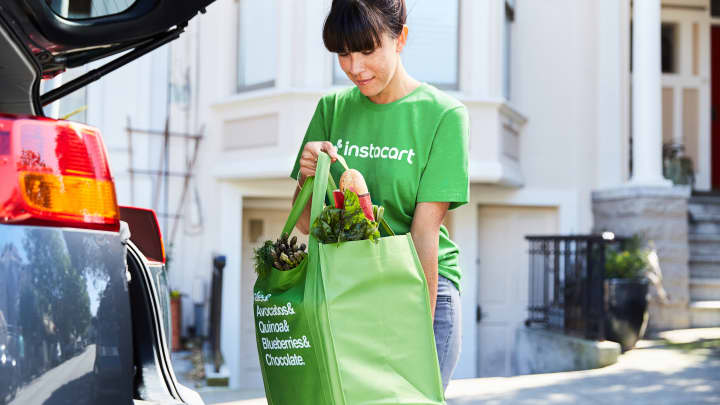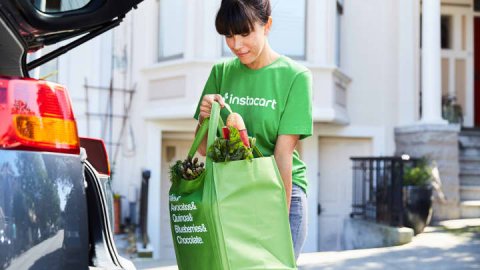
Low valuation defuses the risk that burned investors in , a different Web-fueled food delivery business that went public in December 2020. DoorDash shares closed at $189.51 on their first day of trading, surged to nearly $250, and are now a bit above $80.
Doordash is a good place to start in evaluating Instacart, according to Einhorn.
Indeed, the numbers say Instacart is a lot like DoorDash, but at a fraction of the price.
DoorDash, which mostly delivers restaurant meals, posted a net loss in the first half of this year on sales of $4.17 billion, but made over the prior 12 months, according to its second-quarter report. At today's stock price, Doordash is worth about $32 billion, about 37 times its EBITDA for the 12 months that ended in June and 21 times its 2024 EBITDA, as estimated by ISI Evercore analyst Mark Mahaney.
Instacart, on the other hand, has generated $486 million in EBITDA in the last year, including , reversing a $20 million EBITDA loss in early 2022 as economies of scale kick in. Almost three-fourths of revenue comes from transaction fees of about $16 an order, split between the store and the customer, and about 28% comes from advertising. And the company is asking for a valuation less than one-third as high as DoorDash's, and about a tenth of what DoorDash commanded at its peak.
Instacart's pitch is that online sales are only 12% of the $1.1 trillion Americans spend on groceries, mostly at stores like , and Aldi that are partners with Instacart. The company thinks that share can double, though its roadshow presentation doesn't say exactly how soon. And, in a nod to growth worries, Instacart is also selling itself as a cash-conscious business that invests carefully, with an eye toward short-term returns, while building up its advertising business to keep building profit even as sales growth slows.
That reflects a hard-won skepticism about Web business models that had been powered by Covid-driven hypergrowth, Einhorn said.
"They won't do 2020 growth again and probably will grow less than in 2021 and 2022," he said.
Industry sources are split on how fast Instacart will grow now, said Third Bridge analyst Nicholas Cauley. More aggressive experts consulted by the New York research firm think Instacart can boost gross sales by almost 20% this year and next, helped by market share gains that can be achieved with higher marketing spending after the IPO, he said. Relative pessimists think sales will grow by a high single-digit percentage.
"They have industry leading selection and the app is good for the user," Cauley said.
Indeed, the waning of Covid has tapped the brakes on Instacart's growth The company told analysts on its roadshow that the early part of this year was the first period when it did not think sales were inflated by Covid fears, either the original version or the less-intense recurrence driven by the Omicron variant in late 2021 and early 2022.
Gross sales grew just 3% in the first quarter and 6% in the second three months of 2023, down from the 18% average the company posted in 2021 and 2022. Instacart's revenue grew 31% in the first half of 2023, however, as it added high-margin advertising sales and other income.
The right valuation for Instacart depends on where the ultimate rate of sales growth falls, Einhorn said.
In its roadshow presentation, which , Instacart projects that its long-term business model will capture between 6.5% and 7.5% of each dollar a consumer spends in service charges and other revenue to Instacart (the rest is passed through to grocery stores who sell on the platform). Another 4% to 5% of gross sales will flow to Instacart in the form of advertising revenue, mostly from consumer products companies.
The company's plans turn on getting loyal customers who belong to the company's Instacart+ program, a $99 a year subscription plan that gives free grocery delivery and cash back on some orders, Instacart chief financial officer Nick Giovanni said in the investor presentation. He acknowledges that customers who began shopping at Instacart during Covid have been less loyal than earlier adopters, but said sales to new customers this year are 60% higher than in pre-Covid 2019.
"We expect to see some headwinds," he said.
Instacart+ may be the key to the future, according to Cauley. Members shop more often and spend more each time, and larger orders are more profitable because they use workers' time more efficiently and require less marketing spend.
"Once customers get on the platform, they tend to be sticky," he said.
The company's pitch turns on its ability to boost profits by containing costs as sales grow more slowly. Since its store partners buy and sell the food themselves, Instacart's cost of goods is about the cost of running its Instacart.com platform, which is essentially a locally tailored marketplace of supermarkets that are its partners, and private-label store sites; and of delivering packages to consumers.
The company says those costs will dip to just 22% of revenue, from 28% last year and 25% early this year, as it moves toward its "long-term target" levels. Its capital spending is very low, and its corporate overhead and marketing were 53% of revenue in early 2023. The company believes it can double its EBITDA as a percentage of sales to 39%, according to its presentation.
"When a customer orders more than 20 items, everything about the process is different," Giovanni said.
Instacart's prospectus cites market research firm Incisiv as saying the online grocery market will grow between 10% and 18% annually through 2025. If Instacart regains sales growth of 18%, that would work out to 2025 revenue of $5.9 billion, gross profit of $4.63 billion, and EBITDA of $2.3 billion. Including the cash on the company's balance sheet, that values Instacart at about three times EBITDA – way below DoorDash's valuation.
At 10% growth in merchandise sales, which Einhorn thinks is closer to the mark, Instacart's share of that revenue climbs to as much as $2.88 billion in 2025, with EBITDA of about $1.12 billion. Even that would value the company at only seven times 2025 EBITDA, and about 14 times EBITDA from the last four quarters, still a sharp discount to DoorDash. Grocery giant Kroger trades at 13 times net income.
So in a twist few would have predicted in 2020 or 2021, Instacart is trying to go public as a value stock, carefully managed to wring the best results from potentially modest growth. Investors will soon show whether they are buying.



